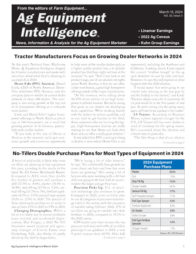Last week in Valley City, N.D., John Deere showcased their largest version of the 1895 No-Till Drill to date with a 60-foot model.
Offered in addition to the release of the drill is the RelativeFlow Blockage Monitoring system, designed to monitor each primary tower and secondary hose on the drill for seeding blockages, and alert users of any particular issues from the cab before they occur.
The technology reflects an ongoing trend among manufacturers to provide growers with immediate alerts, via connective monitors, on seeding performance while also expediting the maintenance process on hoses or openers in the field.
As described by product manager Tyler Rumbold, the Relative-Flow in-cab monitor reacts to sensors on each hose with a color coded system where green represents standard flow, yellow indicates a rate issue and red shows a full blockage.
“You’re able to monitor tower one relative to tower seven, so now we’re just showing flow across the whole drill, relative to each tower, rather than just looking at one tower individually. Then we can blow up a tower and look at each of the secondaries in relation to each other.”
Prior to in-cab notification technology, farmers often only discovered blockages after entire pass was already completed. With a growing expectation for instantaneous data on equipment, these types of features could very well become the standard as opposed to cutting-edge.




Post a comment
Report Abusive Comment